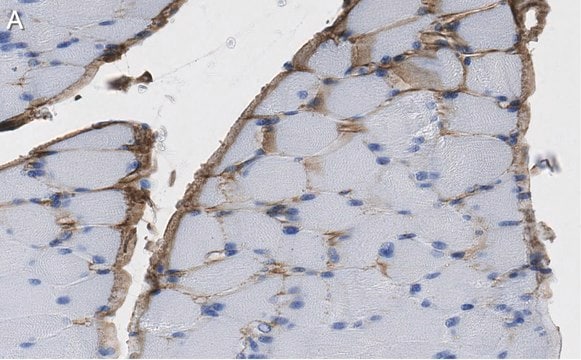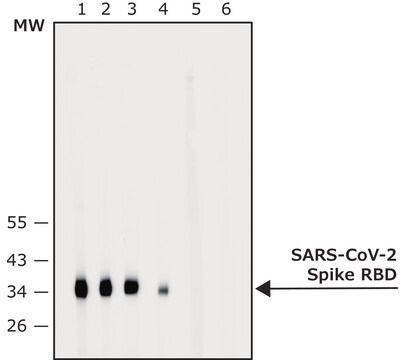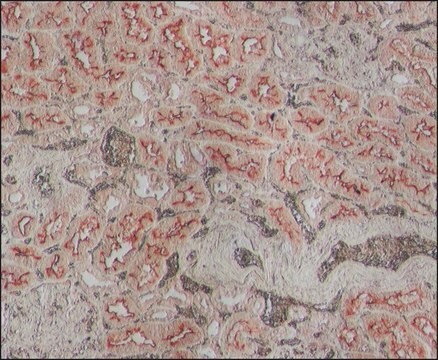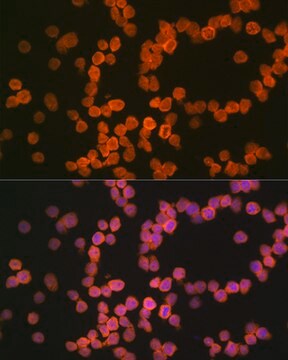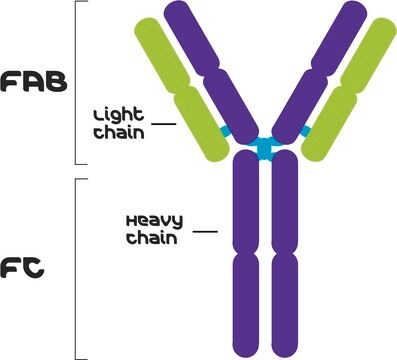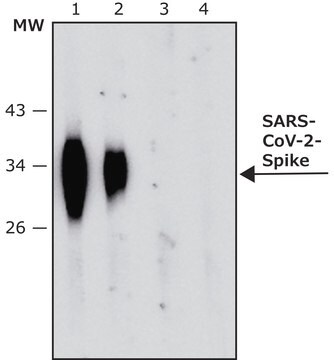ZMS1076
Anti-SARS-CoV-1/2 S Protein Antibody, clone 2B3E5 ZooMAb® Mouse Monoclonal

recombinant, expressed in HEK 293 cells
Sinonimo/i:
Coronavirus S protein, Cov-2 S protein, E2, Peplomer protein, S glycoprotein, SARS-CoV 1/2 Spike glycoprotein
About This Item
Prodotti consigliati
Origine biologica
mouse (recombinant)
Livello qualitativo
Ricombinante
expressed in HEK 293 cells
Coniugato
unconjugated
Forma dell’anticorpo
purified antibody
Tipo di anticorpo
primary antibodies
Clone
2B3E5, recombinant monoclonal
Nome Commerciale
ZooMAb® learn more
Stato
lyophilized
PM
calculated mol wt 139.13 kDa (SARS-CoV)
calculated mol wt 141.18 kDa (SARS-CoV-2)
observed mol wt ~230 kDa
Reattività contro le specie
SARS virus
Confezionamento
antibody small pack of 25 μL
Caratteristiche più verdi
Waste Prevention
Designing Safer Chemicals
Design for Energy Efficiency
Learn more about the Principles of Green Chemistry.
Convalida avanzata
recombinant expression
Learn more about Antibody Enhanced Validation
sustainability
Greener Alternative Product
tecniche
ELISA: suitable
affinity binding assay: suitable
flow cytometry: 1 μg/mL
western blot: 1:5,000
Isotipo
IgG2aκ
Categoria alternativa più verde
, Aligned
Condizioni di spedizione
ambient
Temperatura di conservazione
2-8°C
modifica post-traduzionali bersaglio
unmodified
Informazioni sul gene
SARS coronavirus ... S(43740568)
SARS virus ... S(1489668)
Descrizione generale
Each ZooMAb antibody is manufactured using our proprietary recombinant expression system, purified to homogeneity, and precisely dispensed to produce robust and highly reproducible lot-to-lot consistency. Only top-performing clones are released for use by researchers. Each antibody is validated for high specificity and affinity across multiple applications, including its most commonly used application. ZooMAb antibodies are reliably available and ready to ship when you need them.
Learn more about ZooMAb here.
Specificità
Immunogeno
Applicazioni
Flow Cytometry Analysis: 1 μg/mL from a representative lot detected SARS-CoV-1/2 S protein in Transfected 293 cells (Courtesy of Dr Thomas Moran, Center for Therapeutic Antibody Development).
Western Blotting Analysis: 1 μg/mL from a representative lot detected SARS-CoV-1/2 S Protein in Vero E6 cells +/- SARS-Cov-2 infection (Courtesy of Jeff Johnson Laboratory, Icahn School of Medicine at Mount Sinai (ISMMS).
ELISA Analysis: A multiple Dilution from a representative lot detected SARS-CoV-1/2 S Protein in S1 fusion protein (Courtesy of Dr Thomas Moran, Center for Therapeutic Antibody Development).
Note: Actual optimal working dilutions must be determined by end user as specimens, and experimental conditions may vary with the end user
Descrizione del bersaglio
Stato fisico
Ricostituzione
Stoccaggio e stabilità
Note legali
Esclusione di responsabilità
Data presented is the available current product information and provided as-is. These products have not been tested or verified in any additional applications, sample types, including any clinical use. Experimental conditions must be empirically derived by the user. Our Antibody Guarantee only covers tested applications stated herein and conditions presented in our product information and is not extended to publications.
Non trovi il prodotto giusto?
Prova il nostro Motore di ricerca dei prodotti.
Codice della classe di stoccaggio
11 - Combustible Solids
Classe di pericolosità dell'acqua (WGK)
WGK 1
Punto d’infiammabilità (°F)
Not applicable
Punto d’infiammabilità (°C)
Not applicable
Scegli una delle versioni più recenti:
Possiedi già questo prodotto?
I documenti relativi ai prodotti acquistati recentemente sono disponibili nell’Archivio dei documenti.
Contenuto correlato
Learn more about ZooMAb® recombinant monoclonal antibody technology and how it can provide greater specificity and improved consistency in your immunoassay applications.
Il team dei nostri ricercatori vanta grande esperienza in tutte le aree della ricerca quali Life Science, scienza dei materiali, sintesi chimica, cromatografia, discipline analitiche, ecc..
Contatta l'Assistenza Tecnica.

